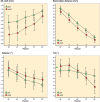The influence of component alignment on patellar kinematics in total knee arthroplasty
- PMID: 25582349
- PMCID: PMC4513599
- DOI: 10.3109/17453674.2015.1005907
The influence of component alignment on patellar kinematics in total knee arthroplasty
Abstract
Background and purpose: Postoperative anterior knee pain is one of the most frequent complications after total knee arthroplasty (TKA). Changes in patellar kinematics after TKA relative to the preoperative arthritic knee are not well understood. We compared the patellar kinematics preoperatively with the kinematics after ligament-balanced navigated TKA.
Patients and methods: We measured patellar tracking before and after ligament-balanced TKA in 40 consecutive patients using computer navigation. Furthermore, the influences of different femoral and tibial component alignment on patellar kinematics were analyzed using generalized linear models.
Results: After TKA, the patellae shifted statistically significantly more laterally between 30° and 60°. The lateral tilt increased at 90° of flexion whereas the epicondylar distance decreased between 45° and 75° of flexion. Sagittal component alignment, but not rotational component alignment, had a significant influence on patellar kinematics.
Interpretation: There are major differences in patellar kinematics between the preoperative arthritic knee and the knee after TKA. Combined sagittal component alignment in particular appears to have a major effect on patellar kinematics. Surgeons should be especially aware of altering preoperative sagittal alignment until the possible clinical relevance has been investigated.
Figures



References
-
- Akagi M, Oh M, Nonaka T, Tsujimoto H, Asano T, Hamanishi C. An anteroposterior axis of the tibia for total knee arthroplasty . Clin Orthop. 2004;420:213–219. - PubMed
-
- Anglin C, Ho K CT, Briard J-L, de Lambilly C, Plaskos C, Nodwell E, et al. In vivo patellar kinematics during total knee arthroplasty . Comput Aided Surg. 2008;13(6):377–91. - PubMed
-
- Baier C, Fitz W, Craiovan B, Keshmiri A, Winkler S, Springorum R, et al. Improved kinematics of total knee replacement following partially naviga... . Int Orthop. 2014;38(2):243–9. - PMC - PubMed
-
- Barrack RL, Schrader T, Bertot AJ, Wolfe MW, Myers L. Component rotation and anterior knee pain after total knee arthroplasty . Clin Orthop. 2001;392:46–55. - PubMed
-
- Bäthis H, Shafizadeh S, Paffrath T, Simanski C, Grifka J, Lüring C. Are computer assisted total knee replacements more accurately placed? A ... . Orthopade. 2006;35(10):1056–65. - PubMed
MeSH terms
LinkOut - more resources
Full Text Sources
Other Literature Sources
Medical
